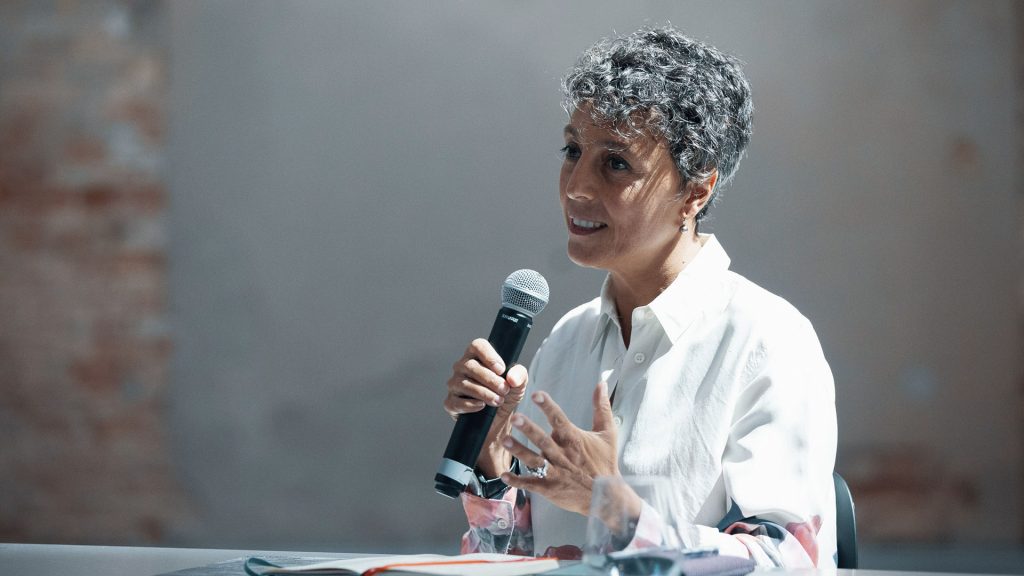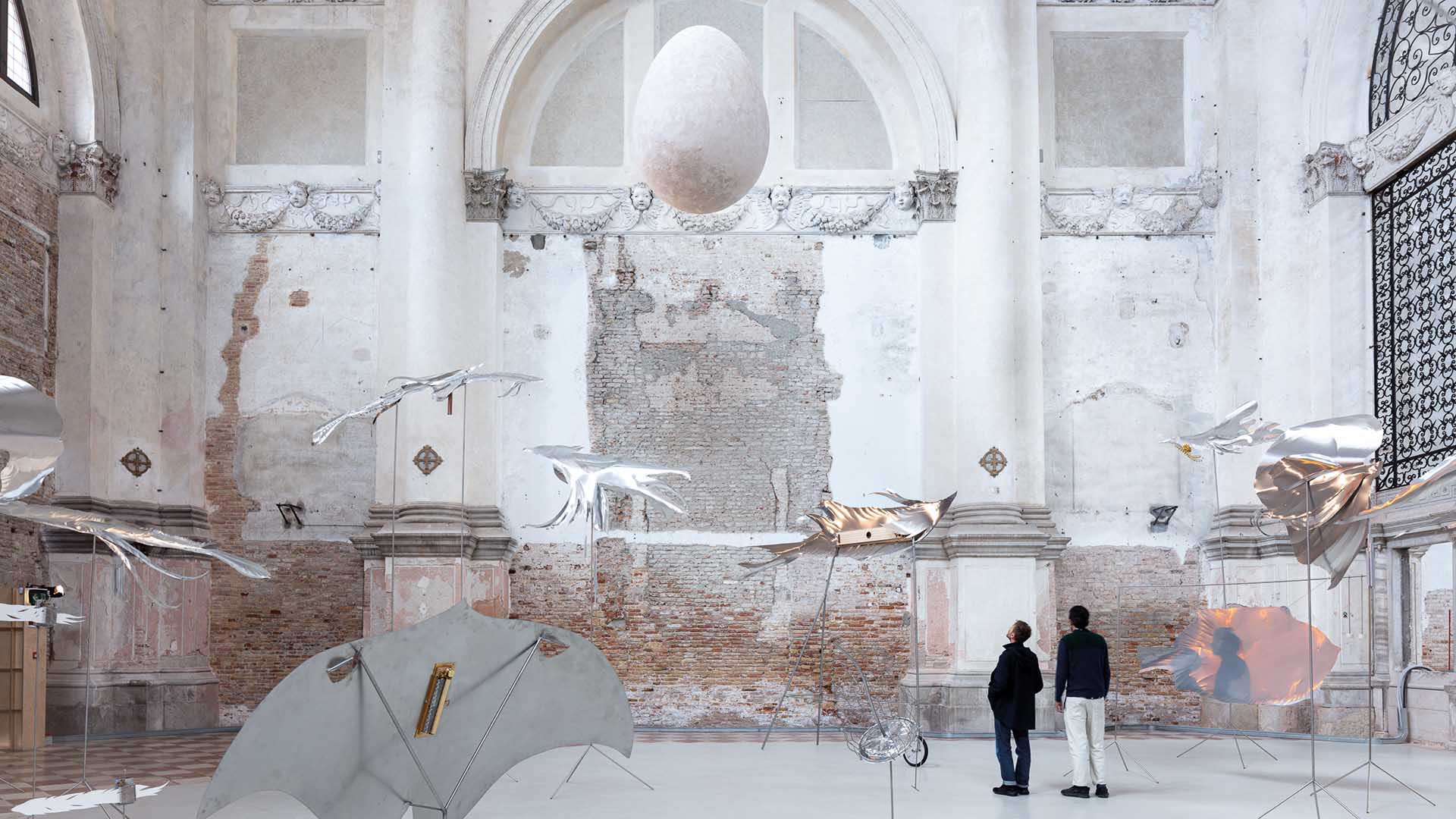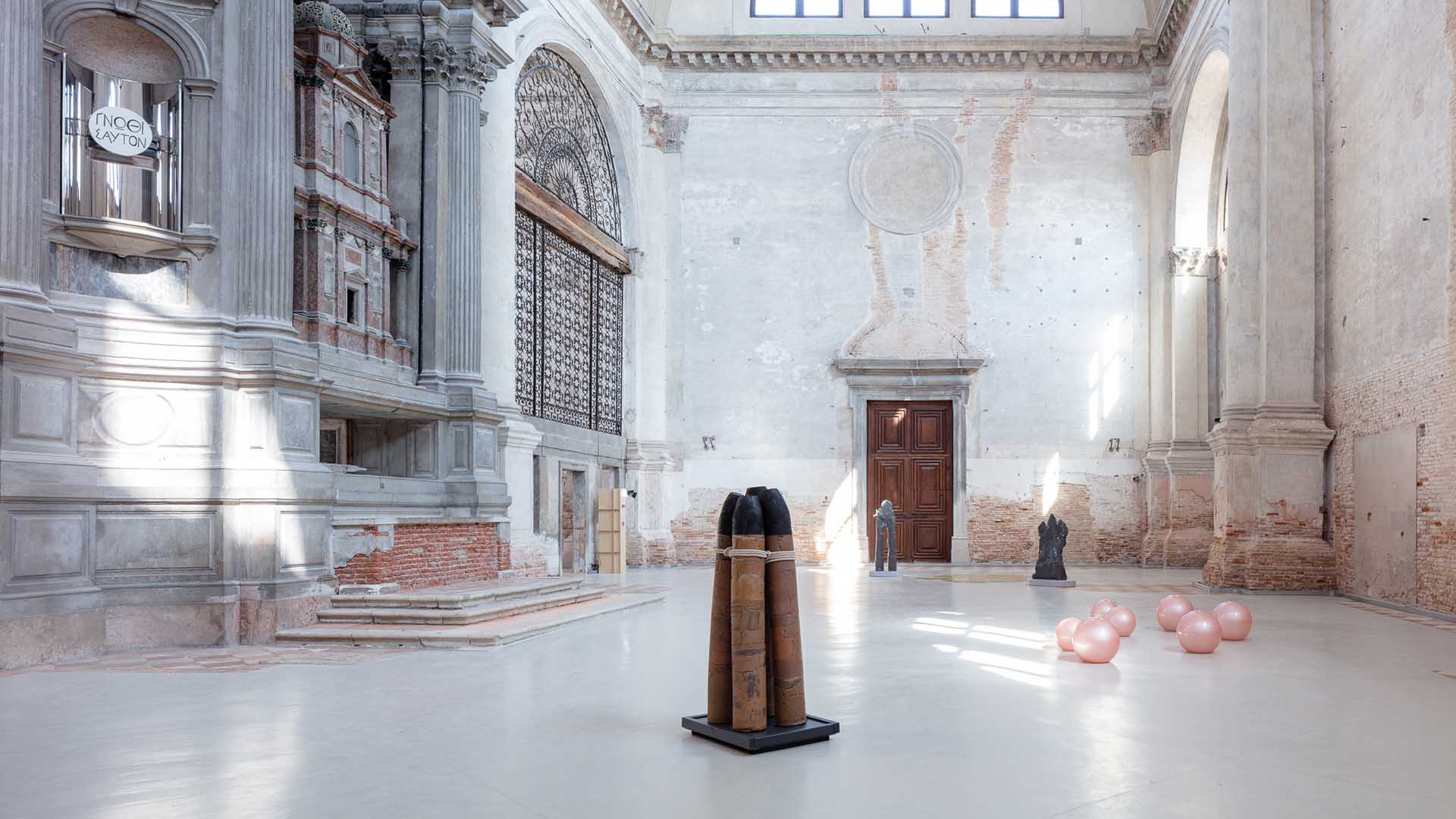
Barbara Casavecchia, curator of the exhibition Thus Waves Come in Pairs, at Ocean Space, guides us through the artworks and installations by Simone Fattal and Berlin-based artistic duo Petrit Halilaj & Álvaro Urbano.
Ocean Space is an ocean – literally. Or multiple, as many as are the waters that touch Venice, its Lagoon, the Mediterranean(s) that are plural, polycentric loci of the culture industry. TBA21–Academy has recently opened Thus waves come in pairs, a title taken from Etel Adnan’s poem Sea and Fog. The exhibition shows the need to reflect on, and with, plurality in our exchanges. Ocean Space commissioned Lebanese-American artist Simone Fattal and Berlin-based art duo Petrit Halilaj & Álvaro Urbano the installation of art and stories of imaginary futures where our understanding of the world is shaped by our encounters with other species, inviting us to listen to a plurality of intelligence. Fattal’s art occupied the Church’s east wing. Several pieces will define a narrative that can be interpreted at multiple levels. Monumental spaces seem to dominate the art, but in fact, they amplify its message. The west wing houses Halilaj’s and Urbano’s installation. The beautiful inauguration performance amplified the identity of this collective art, with the intent of showing the common ground we share, a common ground of history, stories, art, music. This par of the exhibition is fantastic and mythical, ancestral and futuristic all at once. We discussed it with curator, author, and teacher Barbara Casavecchia.

Inspiration in a poem
Thus waves come in pairs is the title I picked not only for the exhibition, but for the whole three-year cycle of The Current III, the curatorship programme sponsored by TBA21–Academy that I have been managing since 2021. That verse by Etel Adnan inspired my work and my research with the concept of plurality: collaboration and sharing with other artists, scientists, activists, starting with reflection on the climate crisis and the narratives we use to describe them, which are all too often one-sided – too western. If change takes place in the Mediterranean at a speed 20% higher than in other parts of the world, why don’t we give more weight to the voices and the experience of those who fought for a longer time with dry weather and extreme temperatures? How many past, present, and future Mediterraneans do we need to confront before we find a shared solution? Specifically, the exhibition will take place at the San Lorenzo Church in Venice, a square church divided in two twin halves. These spaces have been entrusted to Simone Fattal, Etel Adnan’s partner in work and life, and to Petrit Halilaj and Álvaro Urbano, again, partners in both life and work. My goal is to show how plurality is the only way art can affect us.
The Current – a curatorship programme
The Current III is a diverse programme of itinerant conversations that will take us around Venice and its lagoon to fine-tune our perception of change and establish a direct contact with all the natural phenomena that occur here. It also includes two six-month programmes of meetings and debates at Ocean/UNI, our digital platform, called Immagina l’oceano secco come lavanda (lit. ‘imagine if oceans were dry as lavander’), from a poem by Andrée Chedid, and commissions to artists. In summer 2021, artist Giorgio Andreotta Calò walked around the Venetian lagoon – he marked, he recorded, using his body, the separation line between land and water, which changes constantly with the rhythm of seasons and tide, though also as a consequence of human activity and the destruction of the ecosystem. I curated a book, Thus Waves Come in Pairs. Thinking with the Mediterraneans, that includes a conversation between Edel Adnan and Simone Fattal as well as contributions with other authors. The book has been edited, illustrated, and printed in Venice.

The San Lorenzo Church – confronting the space
For me, it has been very important to invite the artists to confront the narratives of the Mediterraneans and the ongoing change that affects them, more so than the architecture. Simone Fattal chose to make us reflect on the stratification of cultures, including colonial cultures: her story, written on pink glass beads made in Murano, is the story of a woman from the island of Djerba, Tunisia, and the western sailor who raped her daughter, protected by the occupation contingent. The story dates back to the thirteenth century, which sadly shows how often such events keep happening, and is written in lingua franca, the pidgin language once spoken in the Mediterranean basin. Slavery has always conditioned the development of European modernity, even though we often gloss over the issue. A title such as Sempre il mare, uomo libero, amerai! (lit. ‘forever the sea, you free man, will love!’) is open to interpretation. A set of metamorphic animal sculptures use sound to communicate, gravitating around a suspended ‘Moon’ – that’s what we call the oval sculpture hanging from the ceiling at Ocean Space. Halilaj and Urbano worked on evolving, transforming life forms that foster queer, alternative futures. The egg is not only the way so many life forms reproduce on earth, but a symbol of cosmology and creation myth. In the inauguration performance, the artists invited musicians and dancers to animate the sculptures, allowing their cry of protest to be heard. It is not merely an aching cry, it is also joyful and energetic. A melody, Ay mi pescadito, forces all motions to coordinate. We must learn how to work together if we want things to change.
What remains, today, of a common Mediterranean identity
I don’t believe this question has, or can have, an answer. Not everything moves at the same pace, not all Mediterranean stories and histories are received in the same way. Individual and collective identities never stop changing. They move and transform, like waves.
Featured images: Barbara Casavecchia – Photo Enrico Fiorese